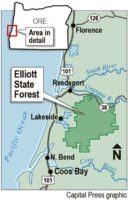In late October 2020, Oregon State University’s College of Forestry released its draft proposal to create the Elliott State Research Forest. This plan remains a work in progress, and Cascadia Wildlands continues to help shape the outcome of it to the point it can be something we can stand proudly behind. As with any complex plan there are trade offs necessary to meet the needs of diverse stakeholders, achieve substantial conservation outcomes, and address legal requirements.
Cascadia Wildlands believes that this plan has the potential to end nearly two decades of conflict over the Elliott State Forest and achieve lasting conservation outcomes. However, a few significant issues remain unresolved. The following are what we view as some of the strengths, compromises and unresolved issues contained in this proposal and encourage you to weigh in through the link above during the ongoing public engagement opportunity.
Plan Strengths
- The plan protects more than 90% of the older forests (>65 years of age) in permanent reserves;
- The plan places 66% of the entire forest (54,154 acres) in permanent reserves;
- The plan creates a 30,000+ acre contiguous reserve on the westside of the Elliott representing more than 37% of the entire forest;
- The plan includes riparian buffers of 120-200 feet in any harvest areas along fish bearing streams and 50-200 feet along perennial non fish bearing streams and 200 foot buffers along the West Fork Millicoma River, significantly stronger riparian protections that provided for in the Oregon Forest Practices Act;
- The plan protects trees and stands greater than 152 years of age which predate the 1868 stand replacement fire on the Elliott;
- In 50 years, more than 70% of the Elliott will be mature forest as compared with approximately 50% today;
- The plan proposes to meaningfully engage western Oregon Tribes in various opportunities;
- The plan prohibits any spraying of herbicides in reserves and limits aerial spraying to 17% of the forest where intensive timber harvest is prescribed and only when no other alternative is practicable;
- The plan bans the use of rodenticides to kill mountain beaver and other wildlife on the Elliott;
- The plan will create the opportunity for significant ecosystem research on a wide array of important topics;
- The plan will increase opportunities for recreation on the Elliott;
- The plan is predicated on full decoupling of the Elliott State Forest from the Common School Fund, which will eliminate pitting school children vs. the environment;
- The plan will keep the Elliott in public ownership;
- The plan creates real potential to bring together historically antagonistic stakeholders in a new era of collaboration for the Elliott.
As with any complex plan, there are also real trade offs:
- Clearcutting will continue on approximately 14,579 acres (18% of the Elliott) and will be limited to second-growth tree farms old, would be done on 60-year rotations (as opposed to 40 years now) and would include stronger riparian buffers as noted above;
- Selective harvest will occur on 14,654 acres which includes approximately 3,200 acres of older forest (>65 years old) including some marbled murrelet occupied habitat;
- Very limited aerial spraying of herbicides (only where other methods are not practicable) will be allowed in clearcuts.
Significant Unresolved Issues that are Still in Process
Governance structure—Cascadia Wildlands and partners are committed to strong public involvement, transparency, and enforcement mechanisms as essential parts of any agreement.
Any final plan must include these elements:
- Recognition and protection of known occupied marbled murrelet sites on the forest;
- The potential to secure carbon credits;
- A Habitat Conservation Plan (which should mirror the OSU Research Forest Plan) supported by federal fish and wildlife agencies;
- Funding mechanisms to complete 100% decoupling of the Elliott State Forest from the Common School Fund. Recall in 2017, the Oregon legislature appropriated $100 million in bonding revenue to put toward to the $221 million price tag on the Elliott, and $121 million is still owed to the School Fund to complete decoupling.
Note that this plan is still being refined so numbers could shift slightly.

Thank you for helping us create a lasting solution for the Elliott State Forest!

